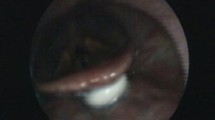Abstract
Normal swallowing requires the close functional coordination of the mouth, pharynx, and esophagus, and if one of these components becomes functionally impaired, it is likely that the others may be affected. Using videofluoroscopy and manometry in this study, we examined the esophageal phase of swallowing in 12 patients with oropharyngeal dysphagia (group A) and the oropharyngeal components of swallowing in 29 patients with esophageal motor dysfunction and nonobstructive dysphagia (group B). A wide range of esophageal function abnormalities was seen in the first group, including delayed esophageal body peristalsis, spontaneous or simultaneous (tertiary) contractions, esophageal body dilation, proximal bolus redirection, and poor lower esophageal sphincter relaxation. Manometrically, 92% of group A patients were classified as having nonspecific esophageal motility disorder (NSEMD). In a similar fashion, group B patients exhibited many oropharyngeal function abnormalities on videofluorography including disturbed lingual peristalsis, slowed pharyngeal transit time with poor constriction of pharyngeal muscles, and laryngeal vestibular and tracheal bolus penetration. Manometrically, group B patients were classified as having NSEMD, achalasia, diffuse esophageal spasm, nutcracker esophagus, scleroderma, and chronic intestinal pseudoobstruction. In conclusion, oropharyngeal function is significantly altered in patients with esophageal motility disorders and dysphagia, and esophageal motor dysfunction occurs in patients with oropharyngeal dysphagia. These changes may represent either a compensatory mechanism or concomitant involvement of the oropharynx or the esophagus by the underlying neuromotor disorder. We suggest that assessment by esophageal motility and videofluoroscopy of both the oropharyngeal and esophageal phases of swallowing may improve diagnosis and therapy in patients with nonobstructive dysphagia.
Similar content being viewed by others
References
Nelson JB, Richter JE: Upper esophageal motility disorders. Gastroenterol Clin North Am 18:195–222, 1989
Christiansen J: Motor functions of the pharynx and esophagus.In Physiology of the Gastrointestinal Tract. LR Johnson, J Christiansen, MJ Jackson, ED Jacobson, JH Walsh (eds). New York, Raven Press, 1987, pp 595–612
Cherry J, Siegel CI, Margulies SI, Donner MW: Pharyngeal localization of symptoms of gastroesophageal reflux. Ann Otolaryngol 79:912–915, 1970
Kahrilas PJ, Dodds WJ, Hogan WJ, Kern M, Ardorfer RC, Reece A: Esophageal peristaltic dysfunction in peptic esophagitis. Gastroenterology 91:897–904, 1986
Jones B, Ravich WJ, Donner MW, Kramer SS, Hendrix TR: Pharyngoesophageal interrelationships: Observations and working concepts. Gastrointest Radiolol 10:225–233, 1985
Enzmann DR, Harell GS, Zboralske FF: Upper esophageal responses to intraluminal distention in man. Gastroenterology 72:1292–1298, 1977
Gerharat DC, Shuck BS, Bordeaux RA, Winship DH: Human upper esophageal sphincter: Response to volume, osmotic and acid stimuli. Gastroenterology 75:268–274, 1978
Pope CE II: Heartburn dysphagia and other esophageal symptoms.In Gastrointestinal Disease, Pathophysiology, Diagnosis and Management. MH Sleisenger, JS Fordtran (eds). Philadelphia, WB Saunders, 1989, pp 200–203
Russell COH: Symptoms of esophageal disease.In The Esophagus. Medical and Surgical Management. L Hill, R Kozarek, R McCallum, CD Mercer (eds). Philadelphia, WB Saunders, 1988, pp 33–35
Logeman JA: Radiographic Symptoms.In Evaluation and Treatment of Swallowing Disorders. JA Logeman (ed). San Diego, College Hill, 1983, pp 73–80
Dalton CB: The manometric study.In Esophageal Motility Testing. DO Castell, JE Richter, CB Dalton (eds), New York, Elsevier, 1987, pp 35–60
Benjamin SB, Richter JE, Cordova CM, Knuff TE, Castell DO: Prospective manometric evaluation with pharmacologic provocation of patients with suspected esophageal motility dysfunction. Gastroenterology 84:893–901, 1983
Jones B, Donner MW, Rubesin SE, Ravich WJ, Hendrix TR: Pharyngeal findings in 21 patients with achalasia of the esophagus. Dysphagia 2:87–92, 1987
Borgstrom PS, Olsson R, Sundkvist G, Ekberg O: Pharyngeal and oesophageal function in patients with diabetes mellitus and swallowing complaints. Br J Radiol 61:817–821, 1988
Author information
Authors and Affiliations
Rights and permissions
About this article
Cite this article
Triadafilopoulos, G., Hallstone, A., Nelson-Abbott, H. et al. Oropharyngeal and esophageal interrelationships in patients with nonobstructive dysphagia. Digest Dis Sci 37, 551–557 (1992). https://doi.org/10.1007/BF01307579
Received:
Revised:
Accepted:
Issue Date:
DOI: https://doi.org/10.1007/BF01307579




